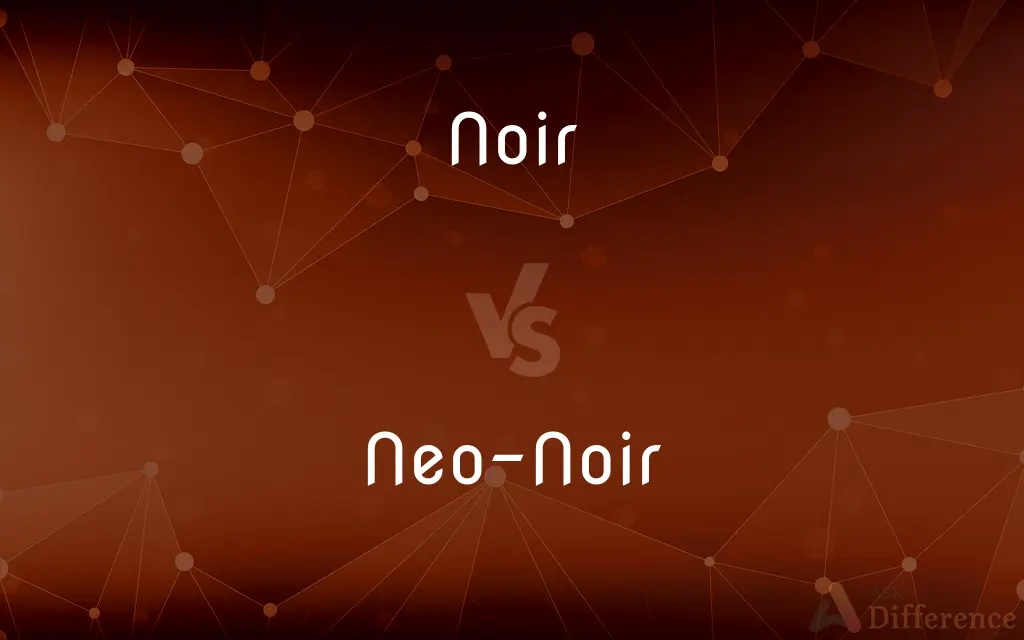Noir vs. Neo-Noir — What's the Difference?
By Tayyaba Rehman & Urooj Arif — Published on February 2, 2024
Noir refers to a film genre of the 1940s-50s characterized by pessimism and moral ambiguity, while Neo-Noir is a modern continuation of Noir themes, updated with contemporary content and style.

Difference Between Noir and Neo-Noir
Table of Contents
ADVERTISEMENT
Key Differences
Noir is a genre that emerged in the 1940s, deeply rooted in American cinema. It's known for its dark, pessimistic themes and shadowy visuals. Neo-Noir, on the other hand, revives these themes in a modern context, often blending them with updated storytelling techniques and visual styles. Both Noir and Neo-Noir explore the darker side of human nature, but Neo-Noir does so with contemporary sensibilities.
The classic Noir films often dealt with crime, moral ambiguity, and complex characters, reflecting the societal anxieties of post-war America. Neo-Noir, while maintaining these core elements, infuses modern settings, issues, and technology into its narratives. Noir's black-and-white visual style symbolizes the clash between good and evil, while Neo-Noir frequently adopts color but maintains the same stark contrast through visual elements.
Noir narratives are typically linear and straightforward, focusing on a central mystery or crime. Neo-Noir, however, is more likely to experiment with narrative structure, incorporating non-linear storytelling and ambiguous endings. Despite these differences, both Noir and Neo-Noir are united by their focus on narrative complexity and the exploration of moral ambiguity.
In Noir, the protagonist is often a disillusioned anti-hero, trapped in a corrupt and oppressive society. Neo-Noir protagonists share this disillusionment but are placed in even more complex, often surreal, environments. Both Noir and Neo-Noir thus offer a critique of society, though the nature and context of this critique have evolved with time.
The visual style of Noir is iconic, with its use of shadows and stark lighting creating a sense of foreboding and uncertainty. Neo-Noir adapts and evolves this visual style, often incorporating modern cinematography techniques and special effects to heighten the emotional impact. Both Noir and Neo-Noir, therefore, use their visual elements to intensify the thematic content of their stories.
ADVERTISEMENT
Comparison Chart
Era
1940s-50s
Late 1960s onwards
Visual Style
Black and white, high contrast
Colorful, yet retains high contrast
Themes
Pessimism, moral ambiguity
Updated themes in a modern setting
Narrative Structure
Linear, focused on crime and mystery
Non-linear, complex, ambiguous
Technological Context
Lacks modern technology
Incorporates modern technology
Compare with Definitions
Noir
Evocative of danger, mystery, or the macabre.
The noir atmosphere of the bar made her feel like she was a character in a 1940s detective story.
Neo-Noir
A genre characterized by morally ambiguous characters, intricate plots, and a pervasive sense of urban decay and corruption.
In 'Chinatown,' the protagonist's investigation into a water scandal leads him deep into the heart of Neo-Noir Los Angeles.
Noir
A genre characterized by cynicism, fatalism, and moral ambiguity.
The detective in the noir film was as morally ambiguous as the shadowy world he inhabited.
Neo-Noir
A cinematic style known for its striking use of shadows, low-key lighting, and intense visual contrasts, often in color.
The Neo-Noir film 'Blade Runner' is celebrated for its dystopian cityscape and iconic neon-lit imagery.
Noir
Pertaining to a style in film and literature that portrays dark and brooding atmospheres.
The noir novel painted a bleak picture of a city plagued by crime and corruption.
Neo-Noir
A genre that explores complex psychological and existential themes within a crime or detective narrative.
In 'Memento,' the Neo-Noir elements are amplified as the protagonist's memory loss adds an extra layer of mystery to the story.
Noir
Involving or suggestive of serious crime, especially murder.
The noir plot revolved around a series of perplexing murders shaking the dark, rainy streets of the city.
Neo-Noir
A modern revival of the classic film noir style, incorporating updated themes and visuals.
The neo-noir movie impressed audiences with its twisty plot and contemporary take on classic noir elements.
Noir
Representing a genre of crime films featuring hard-boiled cynical characters and bleak sleazy settings.
The noir film's protagonist was a jaded detective with a knack for finding trouble in the city's underbelly.
Neo-Noir
A contemporary reimagining of classic film noir elements, updating the genre for modern audiences.
The TV series 'True Detective' is a Neo-Noir masterpiece, weaving a dark and brooding narrative with intricate character development.
Noir
Of or relating to the film noir genre.
Neo-Noir
(uncountable) A genre of film that combines elements of traditional film noir with modern themes and visuals.
Noir
Of or relating to a genre of crime literature featuring tough, cynical characters and bleak settings.
Neo-Noir
(countable) An individual film of this kind.
Noir
Suggestive of danger or violence.
Noir
Of or pertaining to film noir, or the atmosphere associated with that genre
Noir
Film noir.
Noir
A production in the style of film noir.
Common Curiosities
What does "Noir" mean?
"Noir" is a French term that translates to "black" in English. In the context of film and literature, it refers to a genre characterized by dark and cynical themes.
How does Neo-Noir differ from classic Noir?
Neo-Noir is a modern reinterpretation of classic Noir, often with updated settings and themes, while still retaining the core elements of the genre.
What is the origin of the Noir genre?
The Noir genre originated in the 1940s with classic films like "The Maltese Falcon" and "Double Indemnity."
What are some notable classic Noir films?
Some classic Noir films include "Casablanca," "The Big Sleep," and "Sunset Boulevard."
Can Neo-Noir films be in color?
Yes, Neo-Noir films can be in color, but they often retain the moody and visually striking elements associated with the genre.
How does Neo-Noir reflect contemporary issues?
Neo-Noir often incorporates contemporary social, political, and cultural issues into its narratives, making it relevant to modern audiences.
What are the key elements of Noir storytelling?
Key elements of Noir storytelling include moral ambiguity, crime and corruption, complex characters, and a sense of urban decay.
What is "femme fatale" in Noir?
A "femme fatale" is a seductive and often dangerous female character commonly found in Noir stories, who often leads the protagonist astray.
What is the significance of urban settings in Noir and Neo-Noir?
Urban settings in Noir and Neo-Noir symbolize a world filled with moral ambiguity, crime, and corruption, enhancing the dark atmosphere.
Who are some famous Neo-Noir directors?
Directors like Quentin Tarantino, David Fincher, and Christopher Nolan are known for their contributions to the Neo-Noir genre.
What is the enduring appeal of Noir and Neo-Noir genres?
The enduring appeal lies in their exploration of human nature, moral dilemmas, and the allure of darkness, which continue to captivate audiences.
Are Neo-Noir and Crime Thriller the same thing?
Neo-Noir often overlaps with the crime thriller genre, but Neo-Noir places more emphasis on the darker psychological and existential aspects of the story.
What role does lighting play in Noir and Neo-Noir?
Lighting is crucial in creating the signature atmosphere of Noir and Neo-Noir, with strong contrasts and shadows used to evoke mood and tension.
Can Neo-Noir exist in literature?
Yes, Neo-Noir can exist in literature, with authors like James Ellroy and Raymond Chandler known for their Neo-Noir novels.
Is "Blade Runner" considered a Neo-Noir film?
Yes, "Blade Runner" is often classified as a Neo-Noir film due to its dystopian, futuristic setting and thematic elements.
Share Your Discovery

Previous Comparison
HashMap in Java vs. HashSet in Java
Next Comparison
Lower Class vs. Upper ClassAuthor Spotlight
Written by
Tayyaba RehmanTayyaba Rehman is a distinguished writer, currently serving as a primary contributor to askdifference.com. As a researcher in semantics and etymology, Tayyaba's passion for the complexity of languages and their distinctions has found a perfect home on the platform. Tayyaba delves into the intricacies of language, distinguishing between commonly confused words and phrases, thereby providing clarity for readers worldwide.
Co-written by
Urooj ArifUrooj is a skilled content writer at Ask Difference, known for her exceptional ability to simplify complex topics into engaging and informative content. With a passion for research and a flair for clear, concise writing, she consistently delivers articles that resonate with our diverse audience.
















































